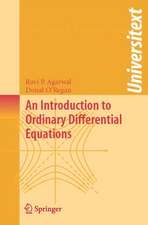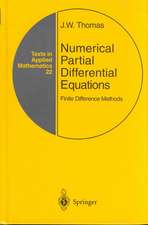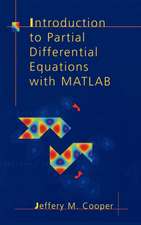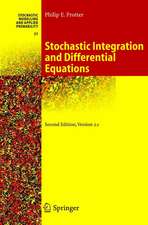Potential Theory: Universitext
Autor Lester L. Helmsen Limba Engleză Paperback – 30 apr 2014
The latter half of the book addresses more advanced material aimed at those with the background of a senior undergraduate or beginning graduate course in real analysis. Starting with solutions of the Dirichlet problem subject to mixed boundary conditions on the simplest of regions, methods of morphing such solutions onto solutions of Poisson's equation on more general regions are developed using diffeomorphisms and the Perron-Wiener-Brelot method, culminating in application to Brownian motion.
In this new edition, many exercises have been added to reconnect the subject matter to the physical sciences. This book will undoubtedly be useful to graduate students and researchers in mathematics, physics and engineering.
Din seria Universitext
- 13%
 Preț: 353.49 lei
Preț: 353.49 lei -
 Preț: 487.96 lei
Preț: 487.96 lei - 15%
 Preț: 543.75 lei
Preț: 543.75 lei -
 Preț: 418.67 lei
Preț: 418.67 lei - 20%
 Preț: 628.22 lei
Preț: 628.22 lei -
 Preț: 322.62 lei
Preț: 322.62 lei - 17%
 Preț: 364.82 lei
Preț: 364.82 lei -
 Preț: 634.38 lei
Preț: 634.38 lei - 17%
 Preț: 427.32 lei
Preț: 427.32 lei - 13%
 Preț: 355.52 lei
Preț: 355.52 lei - 17%
 Preț: 431.50 lei
Preț: 431.50 lei - 19%
 Preț: 429.21 lei
Preț: 429.21 lei - 19%
 Preț: 393.95 lei
Preț: 393.95 lei -
 Preț: 360.08 lei
Preț: 360.08 lei -
 Preț: 358.44 lei
Preț: 358.44 lei - 13%
 Preț: 389.95 lei
Preț: 389.95 lei -
 Preț: 465.61 lei
Preț: 465.61 lei -
 Preț: 371.99 lei
Preț: 371.99 lei - 15%
 Preț: 497.22 lei
Preț: 497.22 lei - 15%
 Preț: 737.46 lei
Preț: 737.46 lei - 17%
 Preț: 394.41 lei
Preț: 394.41 lei - 15%
 Preț: 509.58 lei
Preț: 509.58 lei - 17%
 Preț: 427.68 lei
Preț: 427.68 lei - 8%
 Preț: 495.44 lei
Preț: 495.44 lei - 17%
 Preț: 364.57 lei
Preț: 364.57 lei - 17%
 Preț: 369.08 lei
Preț: 369.08 lei -
 Preț: 396.55 lei
Preț: 396.55 lei - 15%
 Preț: 553.33 lei
Preț: 553.33 lei - 17%
 Preț: 365.35 lei
Preț: 365.35 lei -
 Preț: 356.78 lei
Preț: 356.78 lei -
 Preț: 673.45 lei
Preț: 673.45 lei - 17%
 Preț: 426.76 lei
Preț: 426.76 lei - 20%
 Preț: 569.56 lei
Preț: 569.56 lei -
 Preț: 372.87 lei
Preț: 372.87 lei -
 Preț: 319.07 lei
Preț: 319.07 lei -
 Preț: 379.86 lei
Preț: 379.86 lei -
 Preț: 445.88 lei
Preț: 445.88 lei -
 Preț: 382.36 lei
Preț: 382.36 lei - 15%
 Preț: 533.72 lei
Preț: 533.72 lei - 15%
 Preț: 496.02 lei
Preț: 496.02 lei - 15%
 Preț: 474.82 lei
Preț: 474.82 lei -
 Preț: 389.70 lei
Preț: 389.70 lei -
 Preț: 484.08 lei
Preț: 484.08 lei - 15%
 Preț: 643.48 lei
Preț: 643.48 lei -
 Preț: 415.02 lei
Preț: 415.02 lei - 15%
 Preț: 602.25 lei
Preț: 602.25 lei - 20%
 Preț: 510.24 lei
Preț: 510.24 lei - 15%
 Preț: 588.37 lei
Preț: 588.37 lei -
 Preț: 381.59 lei
Preț: 381.59 lei
Preț: 537.46 lei
Preț vechi: 632.31 lei
-15% Nou
Puncte Express: 806
Preț estimativ în valută:
102.88€ • 111.78$ • 86.47£
102.88€ • 111.78$ • 86.47£
Carte tipărită la comandă
Livrare economică 21 aprilie-05 mai
Preluare comenzi: 021 569.72.76
Specificații
ISBN-13: 9781447164210
ISBN-10: 1447164210
Pagini: 500
Ilustrații: XIV, 485 p. 2 illus.
Dimensiuni: 155 x 235 x 26 mm
Greutate: 0.69 kg
Ediția:2nd ed. 2014
Editura: SPRINGER LONDON
Colecția Springer
Seria Universitext
Locul publicării:London, United Kingdom
ISBN-10: 1447164210
Pagini: 500
Ilustrații: XIV, 485 p. 2 illus.
Dimensiuni: 155 x 235 x 26 mm
Greutate: 0.69 kg
Ediția:2nd ed. 2014
Editura: SPRINGER LONDON
Colecția Springer
Seria Universitext
Locul publicării:London, United Kingdom
Public țintă
GraduateCuprins
Preliminaries.- Laplace’s Equation.- The Dirichlet Problem.- Green Functions.- Negligible Sets.- Dirichlet Problem for Unbounded Regions.- Energy.- Interpolation and Monotonicity.- Newtonian Potential.- Elliptic Operators.- Apriori Bounds.- Oblique Derivative Problem.- Application to Diffusion Processes.
Notă biografică
The author's interests lie in three interrelated topics: heat equations associated with second-order elliptic operators, Markov or diffusion processes and potential theory.
Textul de pe ultima copertă
Potential Theory presents a clear path from calculus to classical potential theory and beyond, with the aim of moving the reader into the area of mathematical research as quickly as possible. The subject matter is developed from first principles using only calculus. Commencing with the inverse square law for gravitational and electromagnetic forces and the divergence theorem, the author develops methods for constructing solutions of Laplace's equation on a region with prescribed values on the boundary of the region.
The latter half of the book addresses more advanced material aimed at those with the background of a senior undergraduate or beginning graduate course in real analysis. Starting with solutions of the Dirichlet problem subject to mixed boundary conditions on the simplest of regions, methods of morphing such solutions onto solutions of Poisson's equation on more general regions are developed using diffeomorphisms and the Perron-Wiener-Brelot method, culminating in application to Brownian motion.
In this new edition, many exercises have been added to reconnect the subject matter to the physical sciences. This book will undoubtedly be useful to graduate students and researchers in mathematics, physics, and engineering.
The latter half of the book addresses more advanced material aimed at those with the background of a senior undergraduate or beginning graduate course in real analysis. Starting with solutions of the Dirichlet problem subject to mixed boundary conditions on the simplest of regions, methods of morphing such solutions onto solutions of Poisson's equation on more general regions are developed using diffeomorphisms and the Perron-Wiener-Brelot method, culminating in application to Brownian motion.
In this new edition, many exercises have been added to reconnect the subject matter to the physical sciences. This book will undoubtedly be useful to graduate students and researchers in mathematics, physics, and engineering.
Caracteristici
Shows how solutions are morphed into local solutions on regions with curved boundaries Discusses the connection between potential theory and Brownian motion Introduces all the important concepts of classical potential theory Equips readers for further study in elliptic partial differential equations, axiomatic potential theory and the interplay between probability theory and potential theory Includes supplementary material: sn.pub/extras












